November 14, 2008
Air Date: November 14, 2008
FULL SHOW
SEGMENTS
Greenbacks for Greener Cars
View the page for this story
With Detroit bleeding red ink and asking for another handout, lawmakers and environmentalist say now is the time to demand green cars from the Big Three automakers. UC-Davis Professor Daniel Sperling tells host Bruce Gellerman any bailout must require affordable, fuel efficient vehicles. (05:20)
Clean Air Champ Challenges Motor City Maven
/ Jeff YoungView the page for this story
Michigan Congressman John Dingell has long looked out for Detroit’s carmakers on Capitol Hill fighting fuel efficiency and tailpipe emissions standards. But now Dingell faces a challenge from one of the greenest Democrats – California’s Henry Waxman - who wants to knock Dingell from his perch atop one of Washington’s most powerful committees. Living on Earth’s Jeff Young tells us what it means for the environment. (05:20)
Cool Fix for a Hot Planet
View the page for this story
Listener Kate Wukasch Kollman of Lafayette, Indiana says when Barack Obama is in the Oval Office, he should encourage Americans to make sacrifices for the environment. Her suggestion: to have at least one car-free day a week. (01:10)
Power Shift
View the page for this story
Thirty-four percent more young voters cast their ballots for Barack Obama than for John McCain. And how influential were environmental issues in their votes? Host Bruce Gellerman talks with Scott Keeter of the Pew Research Center, who analyzed the youth vote. (05:30)
Hug-a-Map Week
View the page for this story
Africa’s southern Sahara is getting greener and the Arctic is melting. These are just two geographic changes depicted in Oxford's latest edition of the Atlas of the World. Host Bruce Gellerman talks with Atlas editor Ben Keene in celebration of Geography Awareness Week. (05:30)
Redefining Rivers
/ Ingrid LobetView the page for this story
Two years ago, the Supreme Court made a landmark ruling on America's rivers that limited the reach of the Clean Water Act. The ruling has many repercussions, especially in the arid Southwest. Living on Earth’s Ingrid Lobet reports. (07:00)
An Eco-Confessional
View the page for this story
Fred Pearce looked around at the things he consumes and collects and embarked on a journey to discover where his stuff comes from. He reports what he found in his new book, “Confessions of an Eco-Sinner: Tracking Down the Sources of My Stuff." Pearce talks with Bruce Gellerman about the serious social and environmental consequences of the production of items many of us take for granted. (08:10)
Colossal Fossil
View the page for this story
After 65 million years, Cliff the Triceratops makes his world debut at Boston’s Museum of Science. Bruce Gellerman reports. (07:45)
This week's EarthEar selection
listen /
download
The Broad-Winged Tree Cricket in late summer.
Show Credits and Funders
Show Transcript
Host: Bruce Gellerman
Guests: Ben Keene, Scott Keeter, Fred Pearce, Daniel Sperling
Reporters: Ingrid Lobet, Jeff Young
[THEME]
GELLERMAN: From Public Radio International, this is Living on Earth.
[THEME]
GELLERMAN: I’m Bruce Gellerman.
With the wheels coming off, Detroit automakers want more billions to bail them out. One green idea: let them fill up at the gas station – a win for the car companies and some consumers.
SPERLING: Let’s finance this whole thing by creating a price floor for gasoline – let’s set it at – like – three and a half dollars a gallon – and some of the funds can be used for those low-income people where it really is a hardship.
GELLERMAN: Also, senators prepare for a smackdown over who leads the committee that deals with Detroit.
And, a museum pieces together the skeleton of a rare dinosaur. Unfortunately, there are no Cliff notes.
BAUM: We’re calling him Cliff because the person who bought the triceratops at the Christie’s auction gets the right to name it, so it’s Triceratops Cliff.
GELLERMAN: No bones about it – Cliff’s back after 65 million years. These stories and more this week on Living on Earth. You’ll dig it!
ANNOUNCER: Support for Living on Earth comes from the National Science Foundation and from Stonyfield Farm.
Greenbacks for Greener Cars
GELLERMAN: From the Jennifer and Ted Stanley studios in Somerville, Massachusetts, This is Living on Earth. I’m Bruce Gellerman, in for Steve Curwood.
They already got 25 billion dollars to help them build more fuel-efficient cars, now America’s Big Three automakers want more, another 25 billion to stay afloat as sales disintegrate. Professor Daniel Sperling of UC-Davis says as long as taxpayers are shelling out so much green, maybe there should be green benefits to the bailout. Professor Sperling is founding director of the Institute of Transportation Studies.
SPERLING: I think this is an opportunity. This is a lot of money, but we can use it to pursue the public interest to do what’s good for society. And I think that means focusing on innovation, especially with respect to low carbon vehicles, fuel-efficient vehicles, the plug in vehicles, the battery vehicles, the fuel cell vehicles.
GELLERMAN: Well how do we get from here to there? How do we insure that this money goes with green strings attached?
SPERLING: I think first of all, we just need to elicit guarantees from those companies that they really are going to roll out large volumes of affordable, fuel efficient, low carbon vehicles. You know, these Detroit companies, GM in particular, really have very strong technological capabilities, but they’re known also for not taking what’s in the lab and bringing it into the market place. They haven’t shown the vision, the commitment, the leadership. And let’s finance this whole thing by creating a price floor for gasoline. Let’s set it at like three-and-a-half dollars a gallon, and we can have a variable tax – if it goes below that, we have a tax to push it up to $3.50. And we can use those funds to support, perhaps some of even the smaller start up companies that are innovative, and some of the funds can be used for, you know, those low income people where it really is a hardship.
GELLERMAN: But is it Detroit’s fault or is it my fault? That is you know, here, you know, people have been asking for SUVs and trucks, the F150 was the best selling vehicle in America for decades. Who got it wrong?
SPERLING: Well, we’re all complicit in that. But, you know, the way to go I think is providing performance standards that they have to meet. They’ve been able to block those for years. You know, the car companies, they just went more and more towards the trucks. They had convinced themselves that this was a smart, strategic, profitable way to go. And they weren’t understanding that circumstances change. And in fact, you know the short-term interests of the customers are not necessarily in the longterm interest of the company or the country or the world.
GELLERMAN: The question is: Who’s gonna make these cars of the future? Is it gonna be the American automakers or is it going to be foreign automakers?
SPERLING: You know, its gotten into this political debate about, you know, supporting the domestic car companies and the jobs versus, you know, the imported cars. But what we’ve seen is these so called imported companies have moved their factories into the U.S. We’re not so dependent. You know the expression back in the 1950’s when the president of GM said, “What’s good for GM is good for America” I think doesn’t hold true nearly as much as it did then.
GELLERMAN: I want you to look at about ten years from now, and predict what the average car will get miles per gallon wise.
SPERLING: Well there’s already the new fuel economy standards adopted last December by the Congress, required a 40 percent increase by 2020. And California has adopted a law, these greenhouse gas standards for vehicles that would push it up another twenty percent. In fact now, the way the market’s going, that’s probably going to be relatively easy to achieve. You know we can push our internal combustion engine cars and trucks up to about double the fuel economy of what it is now, And then, we can take it further with using the plug-in hybrids, electric vehicles, the fuel cells. So we can do much much better than we are now. You know one little factoid I’d give you to illustrate that is in the 1980s, the average car went from 0 to 60 in fourteen and a half seconds. The average car today does that in nine and a half seconds. And that’s being much heavier as well. So what’s happened is, we’ve had all this innovation in the vehicles. But all of that innovation, efficiency innovations been used to make our vehicles faster and more powerful.
GELLERMAN: What we need to do is go from 0-60 miles per gallon faster.
[LAUGHING]
SPERLING: Well, you know, if so extreme. I just saw a Corvette now go zero to sixty in 3.4 seconds. I mean that’s – that’s a rocket. Why do we have these vehicles? If we start backing off just a little bit on that, we’re going to see tremendous improvements in fuel economy.
GELLERMAN: Well Professor Sperling, I want to thank you very much. I really appreciate it.
SPERLING: Well, it’s been a pleasure.
GELLERMAN: UC Davis Professor Daniel Sperling’s new book is "Two Billion Cars: Driving Toward Sustainability."
Related link:
Daniel Sperling
Clean Air Champ Challenges Motor City Maven
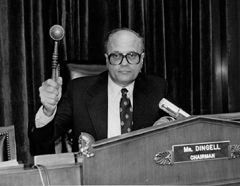
Congressman John Dingell is the longest-serving member of the House. (Courtesy of the House of Representatives)
GELLERMAN: For decades, Congressman John Dingell has championed Detroit carmakers on Capitol Hill. As chairman of the powerful House Energy and Commerce committee, the Michigan Democrat fought fuel efficiency increases and attempts to cut auto pollution, saying they were too costly. Now Congressman Dingell faces a challenge for his job from California Democrat Henry Waxman. As Living on Earth’s Jeff Young reports, this congressional clash of titans could have profound implications for the environment.
YOUNG: If you want to know how important the House Committee on Energy and Commerce is, consider the oversize photograph on the wall of a committee office: it’s a NASA shot of earth taken from space. Chairman John Dingell likes to point at it and say, “This is the jurisdiction of my committee.” It’s only a slight exaggeration.
BECKER: All the bills that affect the atmosphere, global warming, toxic waste, air pollution, water pollution, and pretty much anything else having to do with the environment begin and end in the Energy and Commerce Committee.
YOUNG: That’s Dan Becker with the Safe Climate Campaign. Becker’s battled years for laws to make cars run cleaner and run farther on a gallon of gas. Often, he was battling Chairman Dingell, who looked after his home state’s automakers. Becker’s hopeful the new Congress will put a new chairman in this powerful committee.
BECKER: Under Mr. Dingell the energy and commerce committee has become a graveyard for progressive, pro-environment legislation over the last couple of decades. So the stakes are extraordinarily high. We can either have a leader of this committee who wields the gavel in favor of the environment, or against.
YOUNG: The morning after election day, representative Henry Waxman called Dingell to say he would challenge him for the chairmanship. They’re the two most senior Democrats on the committee but they share little else in common. Waxman represents Beverly Hills, California, which suffers mightily from auto pollution. Dingell represents Dearborn Michigan, home to the Ford Motor Company. And they have starkly different philosophies on environmental regulation. For example, Waxman is eager to have California and 13 other states regulate greenhouse gas emissions from autos.
As chair of the powerful House Oversight Committee, Waxman criticized the Bush Administration for blocking those regulations.

Congressman Henry Waxman. (Courtesy of the House of Representative)
WAXMAN: We need to adopt very strict legislation to reduce greenhouse gas emissions, but at least under the Clean Air Act, the EPA can close down one of the areas that’s most offensive in terms of the amount of CO2 emissions and that’s from motor vehicles.
YOUNG: Dingell saw that as a threat to the auto industry and pushed for bills that agree with the Bush administration’s stance, denying state authority to regulate.
DINGELL: My question is, “Do you want to produce cars, do you want to have
jobs?” We need one good strong regulator. We don’t need a whole lot of people
messing around. And if you’ll look back in 1789 you’ll see the US found they
simply could not tolerate barriers at state borders by a lot of enthusiastic
people who are trying to enrich themselves at the expense of neighbors in other
states.
YOUNG: Veteran environmental activist Frank O’Donnell of Clean Air Watch says
that was just the latest round in a fight that goes back more than 20 years.
Waxman became an early champion of strengthening the Clean Air Act’s reach and enforcement.
O’DONNELL: And Dingell was seen as his obvious adversary who ultimately would side with car companies weakening and rolling back tailpipe standards for cars. He was named at the time “Tailpipe Johnny” by a republican congressman named Ed Madigan, who said, "Look, here comes Tailpipe Johnny!"
YOUNG: O'Donnell says Waxman and Dingell have recently staked out ground for their next and perhaps biggest environmental fight: a bill on global warming.
Waxman sees it as an urgent problem and wants aggressive CO2 cuts. He wants a cap and trade system that auctions its CO2 permits and he’d use the revenue from that auction to invest in clean energy. And he sponsored a bill that would stop coal-fired power plants that do not control CO2 emissions. Dingell released a draft bill last month that proposed more modest emissions cuts over a longer period of time. He’d give CO2 permits to polluting companies. And he’s not about to stop coal power.

Congressman John Dingell is the longest-serving member of the House. (Courtesy of the House of Representatives)
DINGELL: The United States is indeed the Saudi Arabia of coal. I cannot and I will not refuse to have coal be a part of the solution to the problems we confront.
YOUNG: National Mining Association spokesperson Luke Popovich says a global warming bill shepherded through committee by Dingell would better balance economic and environmental concerns.
POPOVICH: I’m not so certain that Congressman Waxman, coming from Beverly Hills, California, is going to be as sensitive to the economic implications of climate change legislation.
YOUNG: That’s a point Dingell makes while trying to round up support from fellow Democrats. In this interview with Detroit talk radio station WJR, Dingell used some sharp language to characterize Waxman.
DINGELL: At a time when the auto industry, American manufacturing, American industry needs somebody to look after them and see that they are fairly treated to get the help they need to survive a desperate situation, he wants to put in an anti-manufacturing, left-wing democrat.
YOUNG: Dingell says he has enough support to keep his post. Waxman says he has the votes to prevail. The issue could be settled soon when Democrats return to Congress for a lame duck session. It’s a power struggle in Congress that could shape how the country powers itself. For Living on Earth, I’m Jeff Young in Washington.
Related links:
- Draft of Dingell’s climate change bill
- To read Waxman’s proposals on climate change and coal power, click here…
- and here…
- and here!
Cool Fix for a Hot Planet
GELLERMAN: It was nearly 50 years ago that JFK delivered his inaugural, “Ask not what your country can do for you…” speech. Now listener, Kate Wukasch Kollman from Lafayette, Indiana has advice for Barack Obama when he takes the oath of office. In this Cool Fix for a Hot Planet.
[COOL FIX THEME]
KOLLMAN: I think President Obama should encourage us Americans to make one specific change or sacrifice for the sake of the environment. And my idea is to ask Americans to have at least one car-free day a week. I think it would make a huge difference for pollution in the air and oil consumption, not to mention that people would be checking out their public transportation options, maybe riding their bikes or doing other things that are not so wasteful and consumerist as we currently do. And it would be a no risk goal for all Americans and if the leader says so, maybe people would do it.
[COOL FIX THEME]
GELLERMAN: And if you have a Cool Fix for a Hot Planet – let us know. If we use your idea on the air, we'll send you a sleek blue Living on Earth tire gauge. Use it to keep your tires correctly inflated and it you could save more than $300 a year. That's according to a study done at Carnegie Mellon University. Call our listener line at 800-218-99-88. That's 800-218-9988. Or email coolfix—that's one word—at loe.org. That's coolfix@loe.org.
[MUSIC: Mike De Castro “Car Groove” from Sweet Sugar Lounge (Supersonique Studio 2007)]
GELLERMAN: Just ahead on Living on Earth: Where on earth you can find all the answers to your geography questions. So stay tuned!
Power Shift
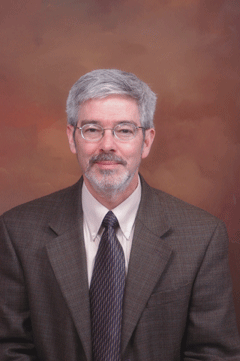
Scott Keeter.
GELLERMAN: It’s Living on Earth, I’m Bruce Gellerman.
Thousands of young demonstrators rallied in the nation’s capital last May to make climate change a primary issue in the Presidential campaign.
[CROWD CHEERING]
TOLKAN: We have been saying for months that we were going to come by the thousands to Capitol Hill because we are the young people that are going to lead this country to the place we need to get to. We came, we’re here, and we are not going anywhere!
[CROWD CHEERING]
GELLERMAN: But did environmental issues actually go anywhere when voters finally went to the polls? Well, with the economy in the dumpster, and two wars dragging on, the environment wasn’t high on voters’ minds, young or old. Scott Keeter studies the youth vote at the Pew Research Center in Washington.
KEETER: Hi, Bruce.
GELLERMAN: So did young people really play a major part in putting President-elect Obama in the White House?
KEETER: I think the answer is yes. They were his best age group, but I think their contribution goes beyond just the votes that they cast. There was a lot of organizational energy and even a lot of young people contributed money, and, of course, there was The Great Schlep, the fact that many young people tried to persuade their parents and grandparents to vote for Obama, so I think the indirect effects may have been very important even if their votes weren’t the deciding factor.
GELLERMAN: And The Great Schlep was the Sarah Silverman video that told people to go to visit their Jewish grandmothers and grandfathers in Florida and go out and vote for Obama.
KEETER: And he won Florida.
GELLERMAN: Well there have been a slew of polls this season. What do the polls actually show in terms of the age demographics, eighteen to thirty?
KEETER: Well young people are, in our own polling, more accepting of the idea that the earth is getting warmer because of human activity. They are less supportive of offshore drilling and less supportive of drilling in ANWR. They are more likely to choose the environment when you pose the environment versus the economy in one of those trade-off type questions, but they’re not necessarily overwhelmingly environmentalists, conventionally defined. For example, the exit poll included a question on drilling in offshore waters where it’s currently not permitted. A majority of young voters actually said that they favored it, though a smaller majority than among other groups. Similarly, in our own polling we find that there has been a shift this year with the gasoline price spike this summer and other concerns about energy supplies – there’s been a shift among young people towards more energy exploration. Still at lower levels than you find among older voters.

Scott Keeter.
GELLERMAN: I’m a boomer, and the modern environmental movement was created, I think basically by boomers. Now we’ve got this Gen Y, the under 30s. They voted for Obama. Is there a different ethos, you think, that motivates them as compared to the boomers in terms of environmental issues?
KEETER: It’s a good question, and I don’t think anybody really knows the answer. Young voters today have grown up in a world where environmentalism was a part of the curriculum in the public schools, where service activities such as volunteering and community problem solving have been very popular, and I think that there is an adaptation on the part of young people to living a more environmentally friendly life. That hasn’t completely translated into pro-environment attitudes in all respects, but there’s definitely a generational change reflected in this group of young people.
GELLERMAN: So as you pore over the Pew data from the 2008 election and were to look ahead to the next elections in 2010 and 2012, how would you see the environment shaping up as an issue going forward?
KEETER: I think it's going to be even more important and for this reason: I think even though gas prices have come down recently, the country got a very serious shock this summer when gas prices went up above four dollars. And I think that it has motivated a lot of thinking about what the reaction of the country should be in terms of achieving energy independence, not just through energy exploration and drilling, but through creative new technologies. That human energy to achieve that, I think, is going to have to come from younger people. And my guess is that the thinking and the policies that go into promoting that are going to make environmental concerns more important in future elections.
GELLERMAN: Scott Keeter is the director of survey research at the Pew research center. Well Scott, thank you very much – appreciate it.
KEETER: My pleasure.
Related links:
- Scott Keeter's recent research on youth voters for the Pew Research Center
- Global Warming and voters
[MUSIC: Bombay Dub Orchestra “Feel: The Diamond Cake Mix” from Bombay Dub Orchestra (Six Degrees Records 2006)]
Hug-a-Map Week
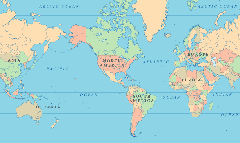
In this Mercator projection of the world Greenland appears much larger than Australia because it is near the edge of the map. In reality Greenland is 3.5 times smaller than the land down under. (Courtesy of worldatlas.us)
GELLERMAN: All right, class, as you know, Geography Awareness Week begins November 16th - so sit up straight, eyes on your own paper. To commemorate the week we’re going to have the Living on Earth snap geo-quiz. Question 1: What’s the most densely populated country in the world? A) Bangladesh. B) Barbados C) Monaco. Question 2: Fill in the blank: What religion in the world has the most followers? We’ll give you the answers, but first let’s talk geography with Ben Keene. He’s editor of the Oxford Atlas of the World. Its latest edition is now out, and Mr. Keene, welcome to Living on Earth.
KEENE: Thanks very much.
GELLERMAN: Boy, this is a big beautiful book. It’s got tons of pictures and the index alone I was counting has a hundred and ten pages. It weighs eight pounds.

Oxford Atlas of the World
KEENE: We didn’t want to really skimp on anything, so we tried to really cram it full of information and maps, and hopefully we achieved that.
GELLERMAN: But you know in a world of Google earth and GPS devices, why on earth do we need an atlas, a paper atlas?
KEENE: An atlas gives you a perspective that you don’t necessarily get online and looking at maps and Google earth. What I like about atlases is that it really is a great way to show you the relationships between things in space. I think there’s something really lovely about letting your mind wander, letting your eye wander. It sort of sparks imagination in a way.
GELLERMAN: Mr. Keene, what’s the biggest change in this year's edition of the Oxford Atlas?
KEENE: That’s kind of a tough question. If you open our Oxford Atlas of the World the first couple of pages we show maps of the poles that show the extent of summer sea ice has actually been shrinking. That is something that you can see quite clearly in our atlas, so that actually scientists are predicting that the Northwest Passage will actually be a reality. One would be able to sail from, you know, Baffin Bay in Greenland over to the Bering Sea and Russia.
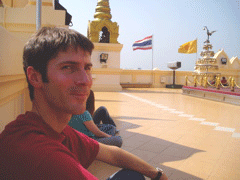
Ben Keene
KEENE: Mm-hmm. Scientists who are working in the Sahel region, which is just the southern edge of the Sahara noticed in a map-able way that vegetation was returning to that part of the world, better land management and just sort of the relocation of people, movement of settlements in that area has changed the geography there.
GELLERMAN: Every map basically has built in lies, you know what I mean? I’m looking at the – Mercator projection - of the world, and Greenland is humongous compared to even Australia – looks bigger. And it's not.
KEENE: Uh-huh.
GELLERMAN: It’s a lot smaller.

In this Mercator projection of the world Greenland appears much larger than Australia because it is near the edge of the map. In reality Greenland is 3.5 times smaller than the land down under. (Courtesy of worldatlas.us)
KEENE: Yeah. I mean, you’re right. Every map does lie. I don’t like to say that publicly…
GELLERMAN: [laughing]
KEENE: … but you’ve caught me. [Laughs] But it’s sort of a lie of necessity. The challenge that mapmakers face is to depict on a flat page or a flat surface something that isn’t flat. So, no matter what type of map projection you use, there’s always going to be some distortion. As you pointed out, the Mercator projection is not particularly successful at keeping the areas of landmasses accurate, especially at the poles – so therefore Greenland looks much larger than it is. But what it is successful at doing is accurately showing the shapes of continents and landmasses. So you try to find a balance between those things, so that the shape and the area are as close to reality as possible.
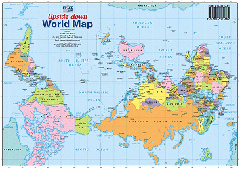
This map showing Australia and South America at the top is just as valid as conventional maps showing them at the bottom of the page.
GELLERMAN: Well, you know, Mr. Keene, Americans are said to be geographically challenged.
KEENE: I think that people in the United States, because we live in a rather large country, we, you know, have two neighbors, Canada and Mexico, and I’m just speculating here, but I think that, in a way, sort of serves to put blinders on us geographically speaking. So that, if you are living in a country that is surrounded by many others, you might just naturally acquire more of a familiarity with those places that immediately surround you in a way that perhaps Americans do not.
GELLERMAN: You’re being very generous, you know that, Mr. Keene.
[LAUGHING]
KEENE: I’m trying to be nice about it, yes. But there was a study that the National Geographic Society did – they were asking questions of people between the ages of 18 and 25 and the respondents from the United States were scoring absolutely at the bottom, so we could probably stand to spend more time with our atlases than we do.
GELLERMAN: Well Mr. Keene, I want to thank you very much.
KEENE: Thank you, Bruce, and I hope that everybody takes the time to go out and look at a map during Geography Awareness Week.
GELLERMAN: Ben Keene is the editor of the new edition of the Oxford Atlas of the World. And here are the answers to our quiz. The most densely populated country in the world? That would be C) Monaco. It has more than 80,000 people per square mile - four-and-a-half times more than the runner-up, Singapore. Question 2: What is the most practiced world religion? That’s Christianity, with more than two billion followers. Happy Geography Awareness Week!
Related link:
National Geographic on Geography Awareness Week
Redefining Rivers
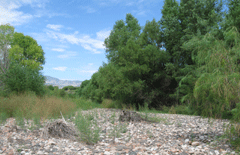
GELLERMAN: And here's a geography fact I wasn't aware of: there are some rivers you can't always see because much of the time they run underground. Until two years ago, most of these seasonal waterways were protected by the Clean Water Act, but a homeowner who wanted to build on a marshy site challenged the federal restrictions and took the case all the way to the Supreme Court. The Court changed some definitions in the act, and that pleased developers - but now environmentalists are making waves. Living on Earth's Ingrid Lobet reports.
[SOUND OF VERDE RIVER]
LOBET: In a few places in Arizona, rivers sound like this:
[SOUND OF RIVER AGAIN]
LOBET: But ….more often …they sound like this:
[SOUND OF BUZZING INSECTS]
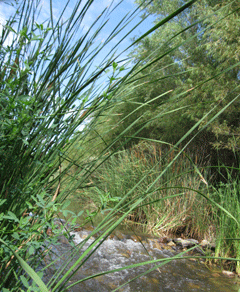
The Verde River. (Photo: Ingrid Lobet)
LOBET: This is the Santa Cruz River in downtown Tucson. The Santa Cruz runs from Arizona south to Mexico and back again, and it's dry in some months. A number of its tributaries have no water visible most of the year. Builders would like to put houses on this dry ground, but they've had to get federal permits from the Army Corps of Engineers, because the Clean Water Act protects "navigable waters." Traditionally that's meant just about all the waters of the United States. Duane Desiderio of the National Association of Home Builders says that's been a problem.
DESIDERIO: The amount of time and money that it takes to get a permit under the Clean Water Act is just inordinate. It literally takes more than a year, and adds to the cost of a house by thousands of dollars. It just has a great impact on affordable housing and the ability of ordinary folks to buy a home.

A dry riverbed of the Verde River. (Photo: Ingrid Lobet)
LOBET: So when the Supreme Court limited which ponds and waterways are protected under the Clean Water Act, builders cheered. Since then, they've been pushing the federal government to relinquish authority over some streams.
DESIDERIO: It can't be the case that the regulatory branch of the federal government should be just so intrusive that it controls every drainage ditch or water body that just becomes wet after a storm.
For southwestern environmentalists though, this tightening of the Clean Water Act is threatening. Matt Skroch is with the Sky Island Alliance in Tucson.
SKROCH: We're now seeing an incredible amount of cases where, not just in southern Arizona, but all over the West, where the Clean Water Act has been significantly undermined, with dozens and dozens of cases where they've avoided or completely circumvented any protection that would otherwise or traditionally have applied to the rivers before the Supreme Court's ruling.
LOBET: Skroch says suddenly it's unclear whether any of the rivers in his region are clearly protected.

Desert flowers in bloom along the Santa Cruz River. (Photo: Ingrid Lobet)
SKROCH: It's literally every river in Arizona except the Colorado.
LOBET: There's a lot of disagreement over what's worth protecting. Paul Green, director of the Tucson Audubon Society says where a developer may see only ribbons of gravel, he sees subterranean water, rivers, the life of the desert.
GREEN: Riparian habitat are about two percent of Arizona's land area and more than 90% of the species that live here depend on those riparian areas for some stage in their life cycle. So these areas have enormous importance to wildlife.
LOBET: And some Westerners think the Supreme Court decision reflects a lack of understanding of rivers in the arid West. The decision is complex, but seems to say in order to be protected as "navigable," tributaries should have relatively permanent and continuous flow. Carolyn Campbell directs the Coalition for Sonoran Desert Protection.
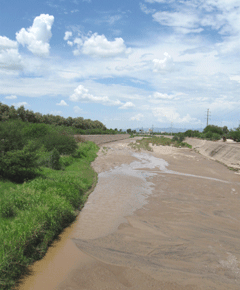
The Santa Cruz River. (Photo: Ingrid Lobet)
CAMPBELL: The Supreme Court decision made fun of the fact that the rivers in the Southwest are nothing like the "free flowing rivers" on the East Coast and the wetlands, so there is a real disconnect from people who are making the decisions, whether it is the Supreme Court or the people in Washington DC, that have a fairly laughable view of the rivers in the Southwest, the Santa Cruz River or the Los Angeles River.
LOBET: It turns out some of the rivers now losing protection are ones that people have recently been trying to reclaim. The Los Angeles River is a good example.
In the 1950s the Army Corps of Engineers encased it in concrete, because its delta flipped around like a fishtail during heavy rain, flooding local neighborhoods. Most of the year, the river would be naturally dry if it weren't for treated sewage effluent. But despite the concrete and treated waste, there's been a major campaign to save the river. Then last spring the government decided 90 percent of it no longer qualified as navigable under the Clean Water Act. Some people were incensed:
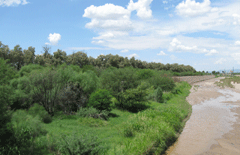
The Santa Cruz River. (Photo: Ingrid Lobet)
WOLFF: So we're here, to defend the right of the people of Los Angeles to use their own river! The city was founded where it was precisely because of the river and despite its current condition, like it or not, it is the heart and soul of the city.
LOBET: George Wolff and eleven other kayak activists set off to prove the Los Angeles River is recreationally navigable.
[SOUND OF PADDLING]
LOBET: Their journey was captured by a team that's making a documentary about the 53-mile paddle.
VOICE OF PADDLER: I'm gonna go down backwards here, looks like one person can do it, but not two - bye bye, see you later…..furious paddling….Oh, look at all these nests along here, cool!
LOBET: Three days later the paddlers climbed out - a little worse for wear, but exhilarated.
[SOUND OF PULLING KAYAKS OUT OF THE WATER, CHEERING]
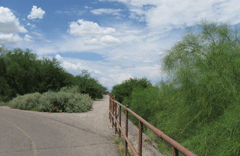
Desert trees and shrubs thrive along the Santa Cruz River. (Photo: Ingrid Lobet)
LOBET: Since environmentalists were challenging the Los Angeles River decision, and homebuilders were challenging federal jurisdiction on the Santa Cruz River, the US Environmental Protection Agency will now decide on both rivers. Benjamin Grumbles, EPA assistant administrator for water agrees the question of authority has become murkier since the Supreme Court decision.
GRUMBLES: We took over these two cases because we feel its important answer some questions to provide greater certainty for those who are looking to protect rivers and streams and understand the limits of jurisdiction under the Federal law, particularly in a desert or arid environment or a highly urban environment such as the LA River.
LOBET: Grumbles says EPA will decide the fate of the Los Angeles and Santa Cruz Rivers soon. In the meantime, 176 members of Congress have signed on to new legislation that would remove the word "navigable" from the Clean Water Act. The builders trade group is strongly opposed.
For Living on Earth, I'm Ingrid Lobet in Los Angeles.
Related links:
- "Rock the Boat," a documentary about the L.A. River
- National Association of Home Builders Comments on River Regulations
- Coalition for Sonoran Desert Protection
- Friends of the Los Angeles River
- Tucson Audubon Society
[MUSIC: Garage A Trois “Etienne” from Outre Mer (Spire Artists Media 2005)]
GELLERMAN: Coming up – the dirt on digging up dinosaurs.
[DINOSAUR ROAR]
GELLERMAN: How do you put a jawbone into a triceratops skeleton?
BAUM: Carefully - very carefully - because it's 65 million years old.
[DINOSAUR ROAR]
GELLERMAN: Keep listening to Living on Earth.
ANNOUNCER: Support for the Environmental Health Desk at Living on Earth comes from the Cedar Tree Foundation. Support also comes from the Richard and Rhoda Goldman fund for coverage of population and the environment. And from Gilman Ordway for coverage of conservation and environmental change. This is Living on Earth on PRI, Public Radio International.
An Eco-Confessional
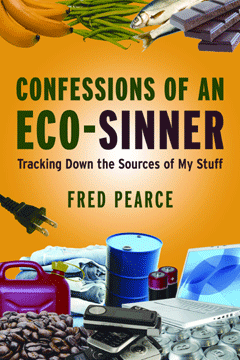
(Courtesy of Beacon Press)
GELLERMAN: It’s Living on Earth, I’m Bruce Gellerman.
Forgive Fred Pearce, for he has sinned. Pearce, a science journalist who covers environmental issues, does his best to be green, but, sometimes he slips. And he ‘fesses up to his environmental transgressions in his new book, "Confessions of an Eco-Sinner: Tracking Down the Sources of My Stuff.” In the book Pearce travels the world exploring the ecological and social cost of his Western European lifestyle, and we follow in his carbon footprints. Fred Pearce, welcome to Living on Earth.
PEARCE: Thank you very much
GELLERMAN: Your trip was sort of a mea culpa, you know, to make amends for all the stuff that clutters your life.
PEARCE: I didn’t see it as making amends, really. I saw it as the ultimate commission, really, the ultimate journey. It gave me a license to go and look at a whole lot of things that I really wanted to look at, and all in the cause of finding where my stuff comes from – connecting me with the rest of the planet if you like, ecologically, but also socially. I think the social issues were as important for me – finding out the people that make my stuff as much as the environmental damage that was often done in making my stuff.
GELLERMAN: And the only thing that you had that whole trip that stayed with you - I’m looking at it right now - is your …
PEARCE: … gold wedding ring. Yup, so the first journey was to go down a South African gold mine which is where the gold for my ring would have come from.
GELLERMAN: I guess the gold from most of our rings come from there.
PEARCE: I think so. For the last forty or fifty years most of the gold in the planet has been coming out of the South African gold mines. And most probably from one of the deepest mines that I went down in. Absolutely fascinating – because you're meeting gold miners down there who’ve been drilling out gold for their whole lives and they’ve never actually seen gold, you know, not even a glint, because the gold is at such a small amount in that rock. So they’re drilling away at this rock in the bowels of the earth. And you know, it’s really hot down there and the air conditioning systems you need in these mines just to keep people alive down there are extraordinary.
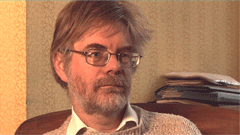
Fred Pearce (Courtesy of Beacon Press)
GELLERMAN: And the amount of water is incredible.
PEARCE: Yeah. When you’re four miles down in the bowels of the earth, it’s very hot. And the only way of keeping it livable is large amounts of water. The miners down there are still – you know, they’re black miners in the way that they were during apartheid time, and they’re paid not much more than they were paid in apartheid days. So it's tough living in that part of the world, I tell you.
GELLERMAN: So how do you feel about your ring now?
PEARCE: I still wear it. There’s a big ecological and social footprint behind something like gold, just the amount of rock, and the social circumstances behind producing just a small amount of metal like that. It’s - my duty to those miners is to carry on wearing that ring, not throw it away.
GELLERMAN: One of the things that you track down is the shrimp that goes in your curry.
PEARCE: Yeah. That was one of the more alarming journeys that I made. I went to Bangladesh. I mean I am an Englishman. I eat in an Indian restaurant in England every Saturday night pretty much. The shrimps come from Bangladesh. I tracked those back, and I met the guy who – a guy who runs one of the ponds, one of the many ponds out there raising these shrimps. He earns about $400 a year for producing shrimps that are valued in London, in the restaurants in London at hundreds of thousands of dollars a year. He’s getting a tiny amount of the money that I pay for that. I followed the journey very carefully because it struck me as very interesting. Between the farmer that I visited and the processing port – about ten miles - on that journey there were seven middlemen. It was a crazy system. It was a kind of mafia-based system. A lot of people were making money out of those shrimps. The farmer wasn’t really making much at all.

(Courtesy of Beacon Press)
PEARCE: Yeah, and I think that’s true. A lot of people, particularly in the U.S. actually, have been campaigning to try to improve the conditions of shrimp farmers. But the problem is finding the wholesalers, finding the retailers in the rich world who are prepared to sign up for this, you know, it'd be a labeling system rather like fair trade labeling system. "Sustainable shrimp" was the logo they were going to go for. Now some parts of the retailing sector, they are getting quite keen on better labeling, fair trade labeling, environmentally friendly labeling. And some of that really does mean something - but in that trade nobody was interested. Really bad news.
GELLERMAN: One of the places you go where commodities are fairly traded is the foothills of Mount Kilimanjaro where they’re dealing with coffee, and I find you’ve really kind of taken the fair trade to task. That is that they’re not giving enough money to the farmers.
PEARCE: In comparison with the shrimp trade, the fair trade people working on coffee and cocoa and bananas or whatever it is are doing good, but the problem is that word, that phrase “fair trade.” It’s not really fair trade, it’s a bit fairer, but that’s about as far as I’d go.
GELLERMAN: So the day you went to the market the fair trade people were paying about $1.46 for a pound of coffee.
PEARCE: That’s right.
GELLERMAN: It was a buck twenty-five ordinarily that day.
PEARCE: That’s right.
GELLERMAN: They were paying a premium.
PEARCE: They were paying a premium, but the prices were still lower than coffee farmers were getting two decades ago, because the problem is the international price of coffee has gone down so much that even if you pay a premium, you pay a bit more, you’re still paying prices that are way down on what they were twenty years ago. The real profits are being made elsewhere in the system, among the traders and the retailers and the brands.
GELLERMAN: Fair trade could be fairer.
PEARCE: Fair trade could be a lot fairer. People talk in the trade about “fair trade lite,” and a lot of fair trade is fair trade lite. We need to pay more, we need to really pay more.
GELLERMAN: I want you to take me down to the Cathedral of Trash. I guess in Britain you produce an average of a thousand pounds of trash per person. Here in the United States we’re up to 1800 pounds?
PEARCE: We produce a lot of trash. I’ve followed where – what happened to my trash. I followed the cart down to "the Cathedral," as the locals call it, where it all gets piled – or most of it gets piled onto a barge, which goes down to a landfill site. That’s pretty straight forward – it just gets landfilled, end of story, until they run out of landfill to put it in. Quite a lot of stuff now though goes to recycling. So an interesting question is well, where does this recycling happen? Does it really happen or, you know, are people making this up? And a lot of our trash, and I would guess a lot of yours too, goes – ends up in China.
When I went to China following this route, I met a woman that they call the Queen of Trash. She currently imports into China six million tons of waste paper and cardboard from North America and from Europe every year. And she turns it into the boxes that go around the electronic goods that then get shipped back to us. But she’s recycling. China gets a bad wrap environmentally these days, but my bet is that if any country in the world is really going to take on recycling in a big way, making sure that we use resources again and again, rather than just hacking them from the rain forest and digging them up from under ground- if any country is going to do that, it is China, and they’ve started. And the Queen of Trash is my hero in that.
GELLERMAN: You traveled 110,000 miles.
PEARCE: I admit it.
GELLERMAN: That’s a big carbon footprint.
PEARCE: Yeah. It's only seven times around the world. And if you work it out in terms of tons of carbon dioxide it works out to 22 tons. So that’s, that’s quite a lot. I don’t ask repentance. I say to anybody who’s critical of that, “well, was the book worth it?” And I don’t know. I hope it was.
GELLERMAN: Well, I must admit that I love to eat shrimp. I have a gold wedding ring. Should I feel guilty?
PEARCE: We shouldn’t generally feel guilty, but I think we should feel that we want to reduce or change our footprint. People used to know, more or less, where their food came from. They used to know the factory that manufactured a lot of the things that they bought in the store. We don’t know any more. And that was the point of my journey, was to try to reconnect. I don’t want to feel guilty, but I think we can, if we learn and take a little bit of time, do things a bit better and hopefully help some people out there in – people working in sweatshops or in bad conditions on farms or in mines or whatever it is.
GELLERMAN: Fred Pearce, thank you very much.
PEARCE: Been a pleasure to be here.
GELLERMAN: Fred Pearce’s new book is called “Confessions of an Eco-Sinner: Tracking Down the Sources of My Stuff.”
Related link:
For more information about Fred Pearce and his books
[MUSIC: Ghosts & Vodka “Nicholas Prefers Dinosaurs” from Addicts And Drunks (Sixgunlover Records 2003)]
Colossal Fossil
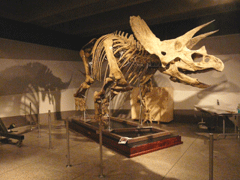
Cliff the Triceratops in his new home. (Photo: Bruce Gellerman)
[DINOSAUR ROAR]
GELLERMAN: In the entrance to Boston’s Museum of Science is a giant wood shipping container stenciled on the side “Air freight: Paris, France.” The box is wrapped in metal chains. A sign challenges museum-goers to guess what’s locked in the crate. From inside the box…a hint…a low rumbling roar…
[DINOSAUR ROAR]
GELLERMAN: 15,000 people submitted guesses. This week, after months of anticipation Boston’s Museum of Science finally took the wraps off, publicly unveiling its newest exhibit: a colossal fossil…a dinosaur skeleton.
Project Director Lynn Baum says it was donated by an anonymous benefactor who bought it at auction in Paris.
BAUM: We’re calling him Cliff because the person who bought the triceratops at the Christie's auction gets the right to name it, and he named it after his grandfather, so it’s Triceratops Cliff.
GELLERMAN: The bones of Cliff the Triceratops were found in 2004 in North Dakota, dug up, shipped to Paris, and, last year, auctioned off for nearly a million dollars. The buyer was from Boston and decided to lend it to the museum for seven years. The day Lynn Baum introduced me to Cliff, workers were putting the finishing touches on him, and he was getting some major dental work done.
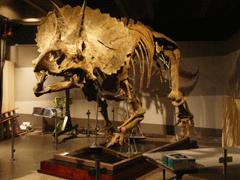
Cliff the Triceratops. (Photo: Bruce Gellerman)
How do you put a jawbone into a triceratops?
BAUM: Carefully, very carefully - because it is 65 million years old.
GELLERMAN: Triceratops roamed North and South Dakota and other western states and Canada during what’s called the late Cretaceous period. They were among the last dinosaurs on earth. Now 65 million years later, the job of putting the thousands of pieces of Cliff’s skeleton back together fell to the museum’s technical director, Kevin McEleney.
MCELENEY: Pretty much we assemble everything and anything...
GELLERMAN: What's the challenge of creating something like this - or recreating something like this?
MCELENEY: Um, trying to figure out how it went together in the first place. We don’t really have a manual to go by, and it’s trying to figure out which part goes where.
GELLERMAN: You didn't have any oops moment, did you?
MCELENEY: No..no oopses.
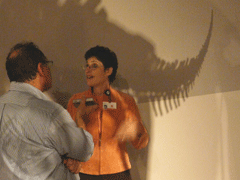
Gellerman interviews Lynn Baum (Photo: Jessie Martin)
GELLERMAN: Triceratops were enormous animals. With his distinctive three horns and mighty frill on his skull, Cliff’s head alone weighs 800 pounds. From nose horn to the tip of his tail, he’s 23 feet long.
Lynn Baum says when it came to completing Cliff’s skeleton, only a relatively small number of bones had to be made or substituted.
BAUM: It’s the fifth bone from the end….if you look at that, it’s a hydrosaur bone, not a triceratops bone.
GELLERMAN: So how much of this skeleton is real bone and real triceratops?
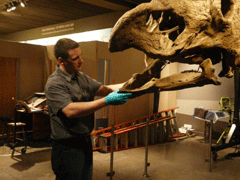
Putting Cliff back together again. (Photo: Jessie Martin)
BAUM: Well, we’re hesitant to give an exact percentage because it gets tricky, because, a lot may even be fractured pieces that have been put together with resin…but it’s well over half, there's well over 50 percent, which makes it one of the top five, six triceratops in the world, which is that complete. There are very, very few nearly complete skeletons - there are no totally complete skeletons.
GELLERMAN: So this is one of the best.
BAUM: This is one of the best … and that’s what’s so exciting about it.
[DINOSAUR ROAR]
GELLERMAN: Alive, Cliff the Triceratops must have been something to behold. Scientists suspect his giant head frill was used to attract members of the opposite sex and fend off attacks from his fiendish nemesis and neighbor, Tyrannosaurus Rex.
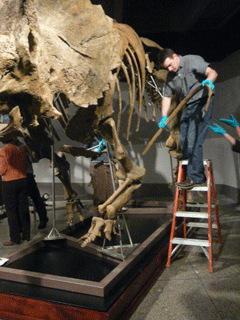
(Photo: Jessie Martin)
GELLERMAN: An herbivore…He didn’t eat meat?
BAUM: Well, think rhinoceros. Very heavily - you know, sturdy, very fierce, herbivores. So you don't want to mess with them, because they were very powerful, but they would have eaten ancient palms, their teeth were designed to actually snip palms like scissors, and if you look at the teeth you can see that they just meet up and down, the top and the bottom…and they had quite a few teeth in their mouth. And they were always shedding teeth, so they were always replacing teeth, sort of like sharks.
GELLERMAN: We know a lot about what triceratops ate and how and where they lived, from paleontologists who study what’s called coprolite.
HOGANSON: We do find a lot of coprolites in North Dakota. I’m not one of those paleontologists who study coprolites but coprolites, as you know, are fossil feces, or fossil turds.

Cliff the Triceratops in his new home. (Photo: Bruce Gellerman)
GELLERMAN: John Hoganson is State Paleontologist of North Dakota. He's in Boston for the opening of the Cliff the Triceratops exhibit. From coprolite, scientists have deduced that the dinosaur-bone-rich Hell Creek formation where Cliff was discovered was once a semi-tropical, hot and humid plain, far warmer than today. The geological record dramatically tells the story. The layer of rock where Cliff was found marks the end of the dinosaur era. Cliff and his kind were victims of cataclysmic climate change, caused when an astroid smashed near the Yucatan peninsula. From coprolite and the evidence in the stratified rocks, we know a lot of life 65 million years ago. But what’s really remarkable, is how little North Dakota State Paleontologist John Hoganson knows about Cliff the Triceratops today.
HOGANSON: Well, Cliff I believe was found in 2004, in southwestern North Dakota, and that’s about all I know. I don’t know who collected the fossil - the next thing I knew it ended up in auction in Paris.
GELLERMAN: But didn’t they have to get a license to dig in the state?
HOGANSON: In North Dakota, like all states in the Union, fossils found on private property belong to the landowner. So the state of North Dakota does not have jurisdiction over fossils found on private lands. We do have jurisdiction over fossils found on the public lands, like state lands or federal lands. So no, we don’t have any regulations that would allow us to ask for information from these commercial fossil collectors as to where they find these fossils.
GELLERMAN: So when you found out that Cliff was being auctioned off in Paris, and it was collected on private land in North Dakota, what was your thought?
HOGANSON: Well as a state paleontologist, and as the paleontologist that's been there for 28 years, these kinds of fossils do disturb us, because we don't know where they're found. Often times they leave the state, so we worry about these fossils ending up in private hands, and therefore not available for education or study.
GELLERMAN: John Hoganson says North Dakota lawmakers are now trying to change state law so private fossil finders will have to report their discoveries. And while he’d like Cliff to one day return home, Hoganson is pleased Cliff’s anonymous owner decided to display the Triceratops skeleton at the Boston Museum of Science.
HOGANSON: I just saw Cliff for the first time a few minutes ago, and they’ve done such a wonderful job here. They’ve got the skeleton postured so it gives the animal some animation to it - It’s nicely done. So we’re very happy this fossil from North Dakota ended up in the Museum of Science for display and study.
[DINOSAUR ROAR]
Related link:
Boston Museum of Science
[MUSIC: Trout Fishing In America “We Are The Dinosaurs” from Big Trouble (The Orchard Records 1991)]
GELLERMAN: Attention Shoppers! Walmart, the world’s largest retailer, is driving a hard bargain with its biggest supplier - China.
WINSTON: They said you have to meet certain environmental and social standards, you have to comply with the law in China which is not what most manufacturers do, and if you don’t – this was the big aha there – was, if you don’t, we will drop you as a supplier.
GELLERMAN: Walmart decides to go green - next time on Living on Earth.
[SOUND OF INSECTS]
GELLERMAN: We leave you this week in the company of Oecanthus latipennis.
[SOUND OF INSECTS]
GELLERMAN: Despite its name, the Broad-winged Tree Cricket lives among low vegetation like goldenrod and other coarse weeds of the eastern United States. In the warm evenings of late summer and early fall, the male crickets trill loudly. But after a light frost, they lower the frequency of their song, and play their tunes just before sunset.
Lang Elliott and Will Hershberger recorded these fiddlers for their CD, “The Songs of Insects.”
[SOUND OF INSECTS]
Living on Earth is produced by the World Media Foundation. Our crew includes Ashley Ahearn, Bobby Bascomb, Eileen Bolinsky, Ingrid Lobet, Helen Palmer, Mitra Taj and Jeff Young, with help from Sarah Calkins and Marilyn Govoni. Our interns are Sandra Larson and Jessie Martin. Jeff Turton is our technical director. Alison Lirish Dean composed our themes. You can find us at LOE dot org. Our executive producer is Steve Curwood. I’m Bruce Gellerman. Thanks for listening.
ANNOUNCER: Funding for Living on Earth comes from the National Science Foundation, supporting coverage of emerging science, and Stonyfield Farm: organic yogurt and smoothies. Stonyfield pays its farmers not to use artificial growth hormones on their cows. Details at stonyfield.com.
Support also comes from you our listeners, the Ford Foundation, the Town Creek Foundation, the Oak Foundation supporting coverage of climate change and marine issues; the Skoll Foundation, supporting social entrepreneurs around the world – uncommon heroes dedicated to the common good. Learn more at skoll.org; and Pax World Mutual Funds: socially and environmentally sustainable investing. Pax World: for tomorrow. On the web at paxworld.com.
ANNOUNCER: PRI, Public Radio International.
Living on Earth wants to hear from you!
Living on Earth
62 Calef Highway, Suite 212
Lee, NH 03861
Telephone: 617-287-4121
E-mail: comments@loe.org
Newsletter [Click here]
Donate to Living on Earth!
Living on Earth is an independent media program and relies entirely on contributions from listeners and institutions supporting public service. Please donate now to preserve an independent environmental voice.
NewsletterLiving on Earth offers a weekly delivery of the show's rundown to your mailbox. Sign up for our newsletter today!
 Sailors For The Sea: Be the change you want to sea.
Sailors For The Sea: Be the change you want to sea.
 Creating positive outcomes for future generations.
Creating positive outcomes for future generations.
 Innovating to make the world a better, more sustainable place to live. Listen to the race to 9 billion
Innovating to make the world a better, more sustainable place to live. Listen to the race to 9 billion
 The Grantham Foundation for the Protection of the Environment: Committed to protecting and improving the health of the global environment.
The Grantham Foundation for the Protection of the Environment: Committed to protecting and improving the health of the global environment.
 Contribute to Living on Earth and receive, as our gift to you, an archival print of one of Mark Seth Lender's extraordinary wildlife photographs. Follow the link to see Mark's current collection of photographs.
Contribute to Living on Earth and receive, as our gift to you, an archival print of one of Mark Seth Lender's extraordinary wildlife photographs. Follow the link to see Mark's current collection of photographs.
 Buy a signed copy of Mark Seth Lender's book Smeagull the Seagull & support Living on Earth
Buy a signed copy of Mark Seth Lender's book Smeagull the Seagull & support Living on Earth

